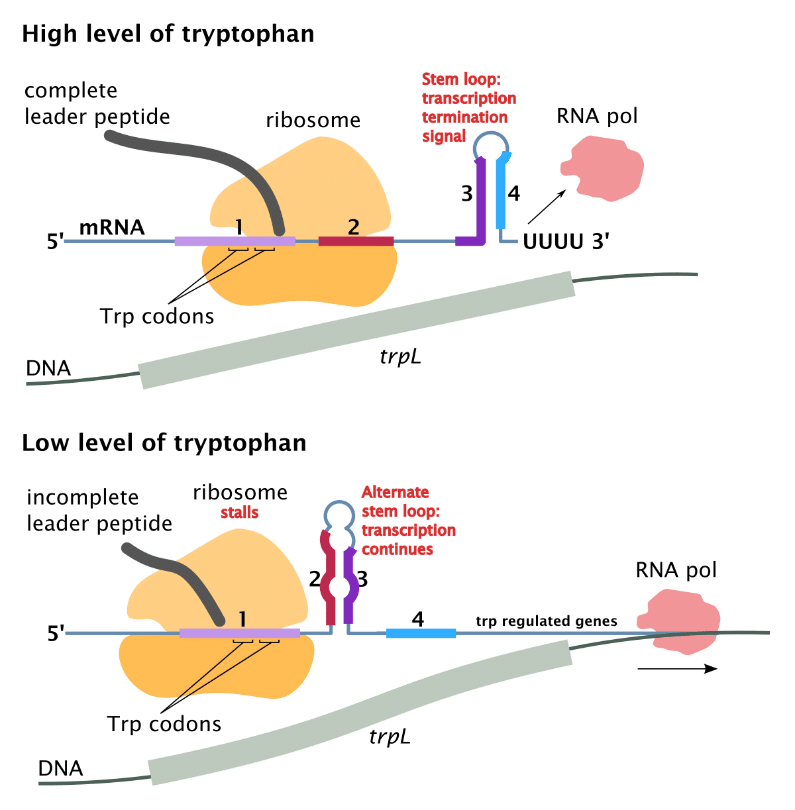In an article yesterday, I gave an example of recurring design logic in the mechanism of repression of two operons, both of which encode genes involved in the biosynthesis of amino acids — namely, tryptophan and arginine respectively. Here, I will focus on another fascinating, and quite ingenious, aspect of these operons — a secondary control mechanism known as attenuation.
What Is Attenuation?
Attenuation is a second level of regulation utilized in bacteria to further fine-tune the expression of operons that are involved in the biosynthesis of amino acids. The best-known example is the tryptophan (Trp) operon, so I will use this as the model system. Attenuation is made possible by the fact that, in prokaryotes, transcription and translation are coupled, such that the ribosome translates an mRNA transcript even while the DNA ahead of it is still being transcribed by the RNA polymerase.
How Attenuation Works
The mechanism of attenuation is illustrated by the figure below.

Key to the process of attenuation is a leader sequence that is transcribed just upstream of the structural genes (this forms the leader peptide shown in the figure). The leader transcript contains the leader peptide-coding region together with four regions that are capable of forming alternative secondary structures by complementary RNA base pairing (known as hairpins). The leader coding sequence contains two adjacent tryptophan codons.
When tryptophan levels are high, the ribosome continues translating through region 1 of the leader transcript and arrives at the stop codon. The physical positioning of the ribosome prevents regions 2 and 3 from forming base pairs with each other. This enables regions 3 and 4 to form a hairpin structure. The 3-4 hairpin is followed by a run of uracils (U’s). This creates an intrinsic terminator, composed of the GC-rich stem-loop and the U-rich sequence. This configuration is inherently unstable when it is formed in the nascent RNA-RNA polymerase-DNA complex since A-U base pairs are less stable than G-C base pairs, and so the RNA-DNA hybrid formed between the template DNA and poly-U tail is weak. Moreover, the hairpin physically disrupts the RNA polymerase. Thus, the RNA polymerase is inhibited from transcribing the Trp operon.
When tryptophan levels are low, on the other hand, the ribosome, upon arriving at the two adjacent Trp codons in region 1, stalls. Region 2 is now able to form a hairpin structure with region 3, which means that region 4 does not form a hairpin. The RNA polymerase is, therefore, able to continue to transcribe the Trp operon.
Attenuation Regulates the Biosynthesis of Other Amino Acids
This mechanism of attenuation is employed not just as a means of controlling the Trp operon, but also for operons that encode the enzymes for the biosynthesis of other amino acids (e.g. phenylalanine, histidine, threonine, leucine, and isoleucine-valine). In each case, there is a string of the relevant amino acid at which the ribosome will stall when there is a shortage. For example, the phenylalanine operon has seven phenylalanines in its leader peptide; the histidine operon has seven histidines in its leader peptide, and so forth.
Recurring Design Logic
As with previous examples I’ve discussed, despite the striking parallels between these systems in terms of the design logic, these attenuation systems are not evolutionarily related to one another. Indeed, the leader sequences of these different operons exhibit no significant homology. This is the sort of recurring pattern that one might expect to see in designed systems, but it is more surprising in stochastically evolved systems. It therefore suggests that operon regulation is best understood as the product of engineering rather than blind, unguided processes.
